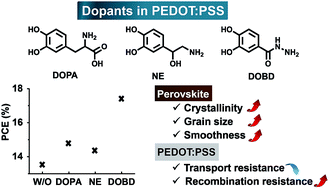Catechol derivatives as dopants in PEDOT:PSS to improve the performance of p–i–n perovskite solar cells†
Abstract
For planar p–i–n perovskite solar cells (Pero-SCs), the bottom hole transporting layer (HTL) material is crucially important, since it can greatly affect the device performance in two aspects: (1) hole collection and transportation and (2) the crystallinity of the perovskite layer formed on it. Herein, a series of catechol derivatives, L-3,4-dihydroxyphenylalanine (DOPA), norepinephrine (NE) and 3,4-dihydroxybenzhydrazide (DOBD), were employed as dopants in PEDOT:PSS and applied as HTLs, and the influence on performance of p–i–n Pero-SCs was systematically studied. It is found that all these three catechols can improve the power conversion efficiency (PCE) of the Pero-SCs, among which DOBD shows far better performance than the other two. Under optimized conditions, a PCE of 17.46% was achieved for the p–i–n Pero-SCs using DOBD-doped PEDOT:PSS as the HTL. The investigations on morphology, fluorescence and electrochemical impedance spectra indicate that the PCE improvement should be mainly attributed to the facilitated charge collection and transportation due to the doped HTL and the enhanced crystallinity of the perovskite films. This line of research demonstrates that the easily accessible catechols can be employed as an excellent dopant in PEDOT:PSS for application as HTLs in Pero-SCs and opens a novel avenue for further improving the performance of the devices.



 Please wait while we load your content...
Please wait while we load your content...